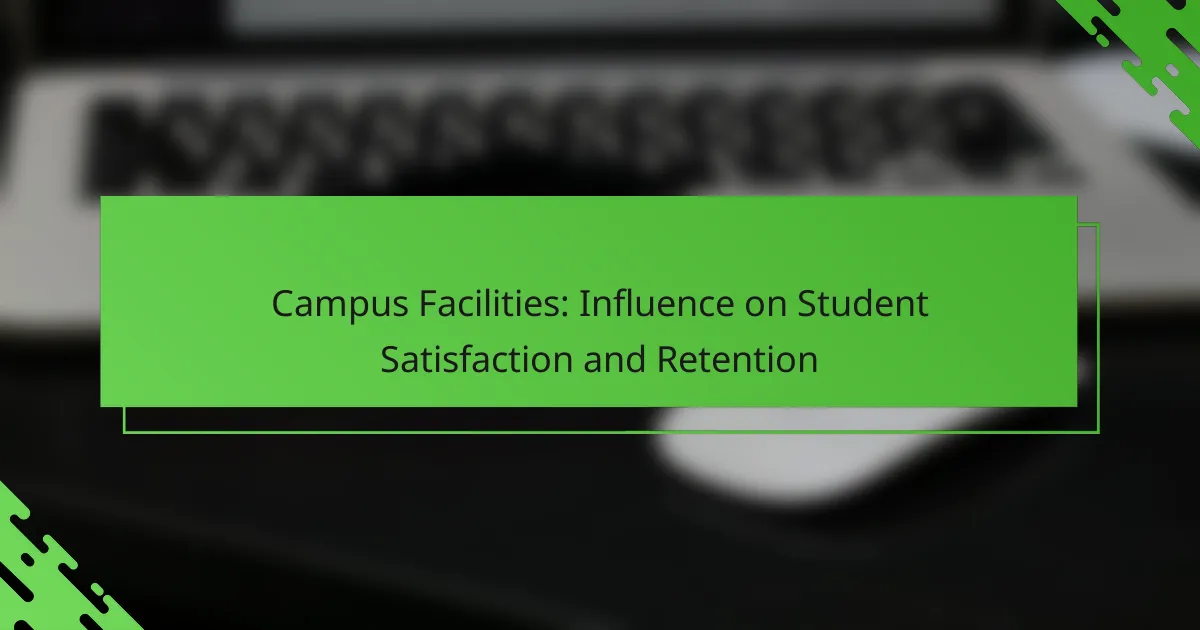Sports facilities play a crucial role in enriching student life and engagement at universities by offering essential spaces for physical activity and social interaction. By promoting participation in sports and recreational activities, these facilities not only enhance physical health but also foster a sense of community, ultimately contributing to a vibrant and dynamic campus environment.
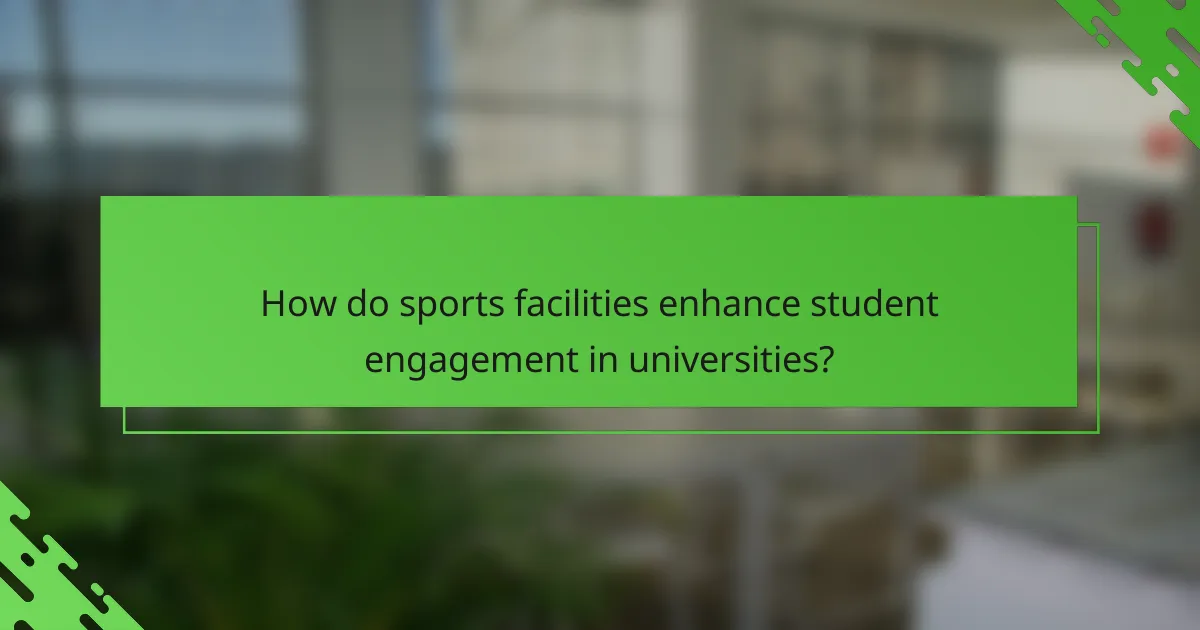
How do sports facilities enhance student engagement in universities?
Sports facilities significantly enhance student engagement in universities by providing spaces for physical activity, social interaction, and community building. These facilities encourage participation in sports and recreational activities, fostering a vibrant campus life.
Improved physical health
Access to sports facilities promotes regular physical activity, which is essential for maintaining good health. Engaging in sports can help students manage stress, improve cardiovascular fitness, and maintain a healthy weight.
Universities often provide various options, such as gyms, swimming pools, and sports fields, allowing students to choose activities that suit their interests. Regular participation can lead to long-term health benefits, including reduced risk of chronic diseases.
Increased social interaction
Sports facilities serve as social hubs where students can meet and interact with peers. Participating in team sports or group fitness classes fosters camaraderie and builds friendships, enhancing the overall university experience.
Events like intramural leagues or fitness challenges encourage students to collaborate and compete, creating a sense of community. These interactions can lead to lasting relationships and a support network throughout their academic journey.
Enhanced school spirit
Well-maintained sports facilities contribute to a strong sense of school spirit among students. When universities host sporting events, students rally together to support their teams, fostering pride and loyalty to their institution.
Cheering for teams and participating in events can create a lively campus atmosphere, encouraging students to engage more fully in university life. This spirit can also extend beyond sports, influencing academic and social activities.
Opportunities for leadership
Sports facilities provide numerous opportunities for students to take on leadership roles, whether through team captaincy, organizing events, or coaching peers. These experiences can enhance personal development and build valuable skills.
Participating in sports management or student-led organizations related to athletics can also prepare students for future careers. Leadership in sports fosters teamwork, communication, and decision-making abilities that are beneficial in any professional setting.
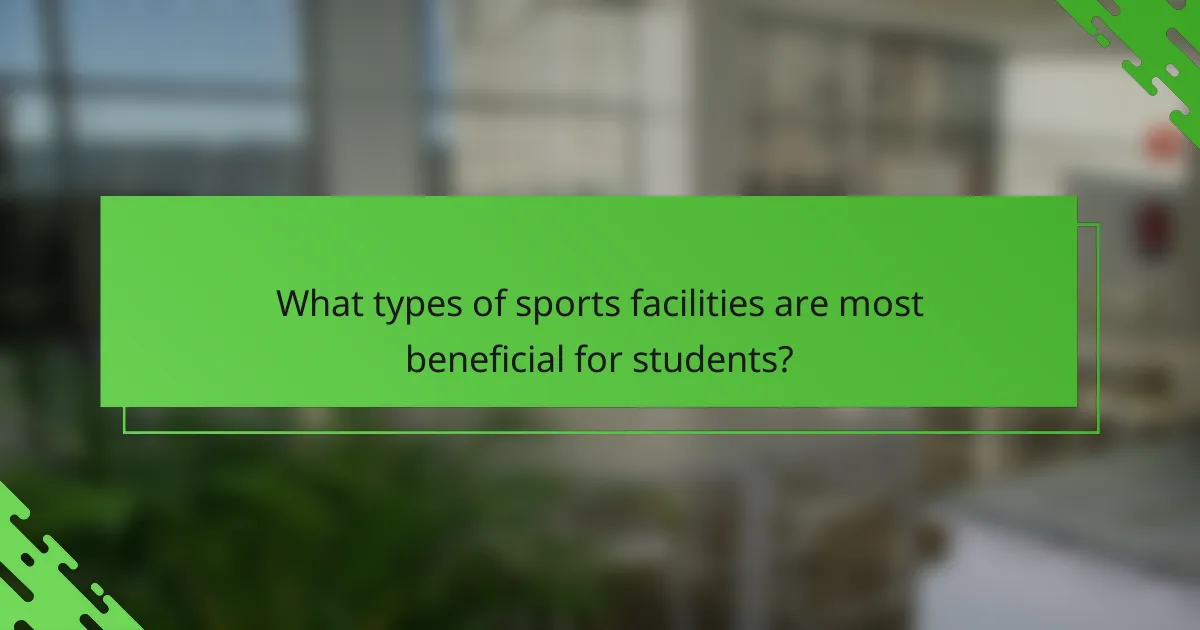
What types of sports facilities are most beneficial for students?
Sports facilities that are most beneficial for students include multi-sport complexes, athletic training centers, and outdoor recreational areas. These facilities enhance physical health, foster social connections, and improve overall student engagement in campus life.
Multi-sport complexes
Multi-sport complexes provide versatile spaces that can accommodate various sports and activities, such as basketball, volleyball, and swimming. These facilities encourage participation by offering diverse options, catering to different interests and skill levels.
When designing or utilizing a multi-sport complex, consider the layout and accessibility. Facilities should be centrally located and equipped with necessary amenities like locker rooms and seating areas. This ensures that students feel comfortable and motivated to engage in physical activities.
Athletic training centers
Athletic training centers focus on enhancing student athletes’ performance through specialized equipment and professional guidance. These centers typically include weight training areas, conditioning rooms, and rehabilitation facilities, which are essential for injury prevention and recovery.
To maximize the benefits of athletic training centers, institutions should provide access to qualified trainers and nutritionists. Regular workshops on injury management and fitness strategies can further empower students to take charge of their athletic development.
Outdoor recreational areas
Outdoor recreational areas, such as parks and fields, offer students a chance to engage in physical activities in a natural setting. These spaces can host sports like soccer, frisbee, and running, promoting a healthy lifestyle while allowing for social interaction.
When planning outdoor recreational areas, consider incorporating features like walking trails, picnic spots, and fitness stations. These additions can enhance the appeal of the space, encouraging more students to participate in outdoor activities and fostering a sense of community on campus.
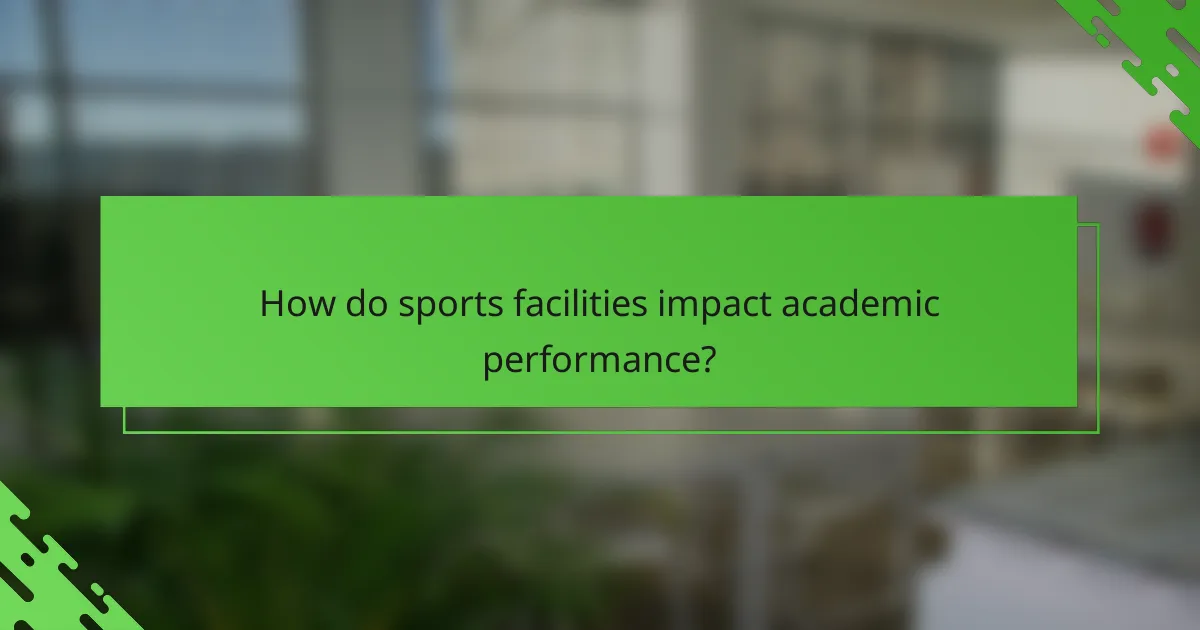
How do sports facilities impact academic performance?
Sports facilities significantly enhance academic performance by promoting physical activity, which is linked to improved cognitive function and focus. Access to well-maintained sports amenities encourages students to engage in regular exercise, leading to better concentration and overall academic success.
Boosted concentration levels
Engaging in sports and physical activities can lead to increased concentration levels among students. Regular exercise stimulates the release of neurotransmitters that enhance brain function, making it easier for students to focus on their studies. For instance, participating in team sports or fitness classes can provide a mental break, allowing students to return to their academic work with renewed focus.
Additionally, facilities that offer a variety of sports options can cater to different interests, encouraging more students to participate. This inclusivity can foster a sense of community, further enhancing students’ motivation to engage in their studies.
Improved time management skills
Utilizing sports facilities can help students develop better time management skills. Balancing academic responsibilities with sports commitments requires students to prioritize tasks and create structured schedules. For example, students who participate in sports may learn to allocate specific times for studying, practice, and rest, leading to more efficient use of their time.
Moreover, the discipline gained from regular training and competition can translate into improved academic performance. Students often find that the skills they acquire in sports, such as setting goals and adhering to a routine, can be applied to their studies, resulting in better academic outcomes.
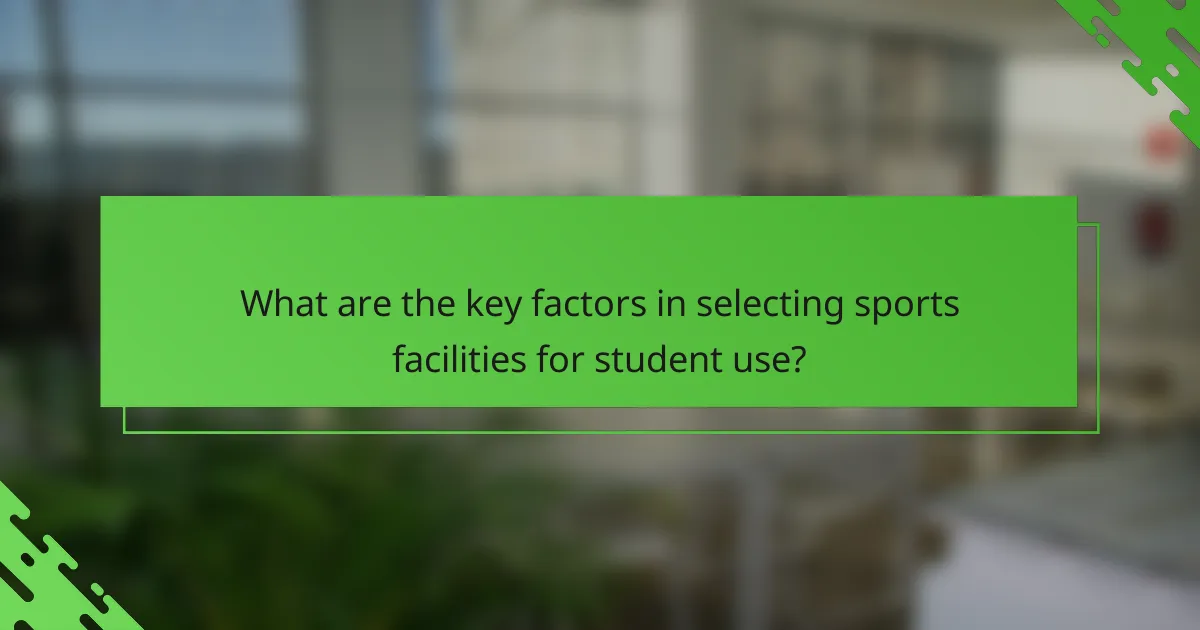
What are the key factors in selecting sports facilities for student use?
Key factors in selecting sports facilities for student use include accessibility, facility quality, and maintenance. These elements significantly influence student engagement and participation in sports activities, ultimately affecting their overall campus experience.
Accessibility and location
Accessibility and location are crucial for ensuring that students can easily reach sports facilities. Facilities should be situated within a short walking distance or have reliable transportation options to encourage regular use.
Consideration should also be given to the availability of parking and the presence of ramps or elevators for students with disabilities. A well-located facility can significantly increase student participation rates.
Facility quality and maintenance
The quality and maintenance of sports facilities directly impact student satisfaction and safety. Facilities should be equipped with modern equipment, clean environments, and adequate lighting to create a welcoming atmosphere.
Regular maintenance checks are essential to ensure that all equipment is functional and safe for use. Institutions should establish a routine maintenance schedule and gather student feedback to identify areas needing improvement.
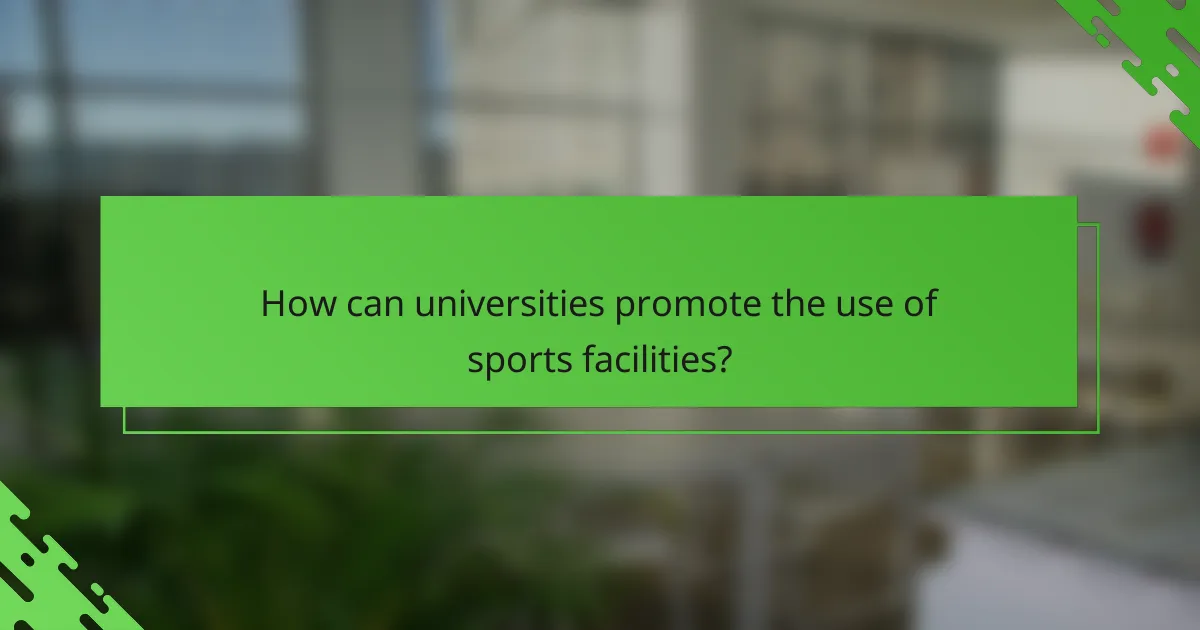
How can universities promote the use of sports facilities?
Universities can enhance the utilization of sports facilities by creating engaging programs and fostering a culture of participation. This involves organizing events, offering diverse fitness classes, and ensuring facilities are accessible and well-maintained.
Organizing events and competitions
Hosting events and competitions is an effective way to encourage student participation in sports facilities. These can range from intramural leagues to tournaments that cater to various skill levels, allowing students to compete and socialize.
Consider scheduling events during peak times, such as weekends or early evenings, to maximize attendance. Collaborating with student organizations can also help in promoting these activities and ensuring they meet the interests of the student body.
Offering fitness classes
Providing a variety of fitness classes can attract students to sports facilities and cater to different interests and fitness levels. Classes such as yoga, pilates, and high-intensity interval training (HIIT) can appeal to a broad audience and encourage regular participation.
It’s beneficial to offer classes at different times throughout the week to accommodate varying schedules. Additionally, consider providing introductory sessions or free trials to entice students to try new activities without commitment.
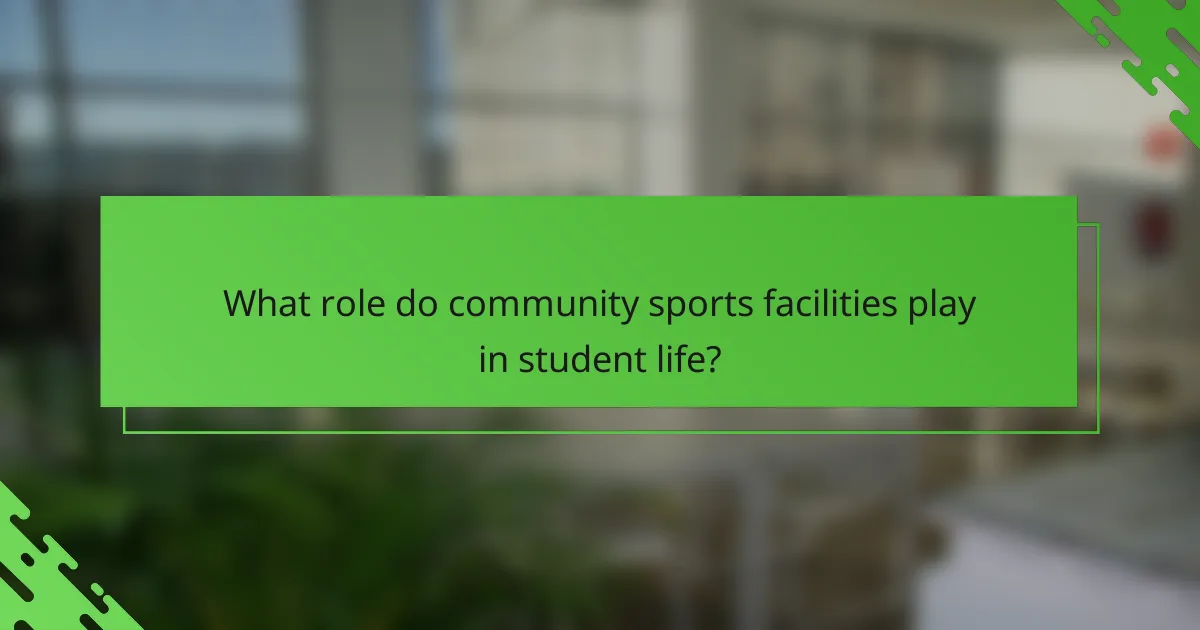
What role do community sports facilities play in student life?
Community sports facilities significantly enhance student life by providing spaces for physical activity, social interaction, and personal development. These facilities encourage participation in sports and recreational activities, fostering a sense of belonging and community among students.
Fostering community engagement
Community sports facilities serve as hubs for student engagement, bringing together individuals from diverse backgrounds. They offer opportunities for students to participate in organized sports, fitness classes, and social events, which can strengthen relationships and build networks.
Participation in community sports can lead to increased school spirit and pride. Events such as tournaments or fitness challenges not only promote healthy competition but also encourage teamwork and collaboration among students, enhancing their overall college experience.
To maximize community engagement, institutions should promote these facilities through outreach programs and partnerships with local organizations. This can include hosting open days, workshops, or community leagues that invite students to join and participate actively.


